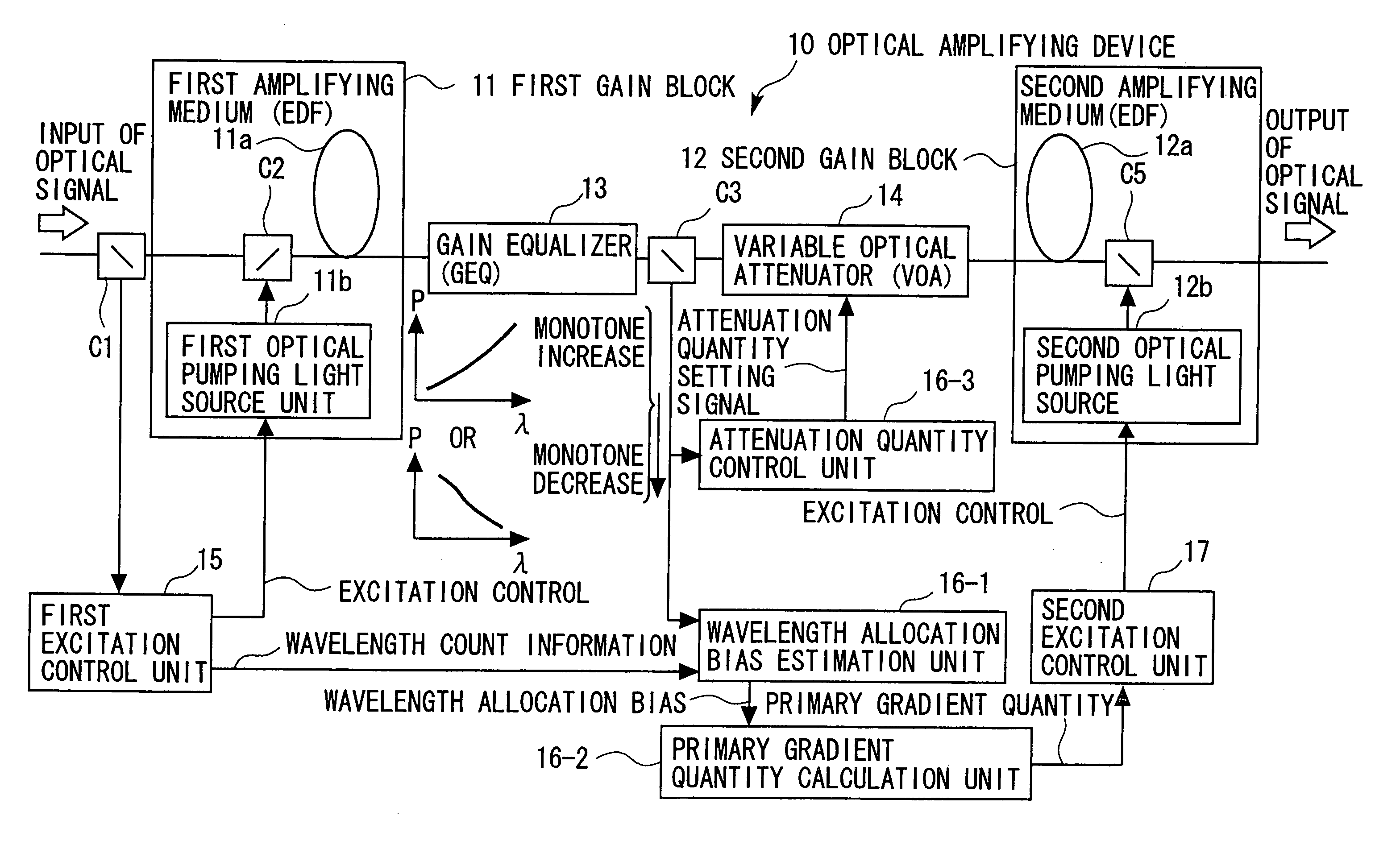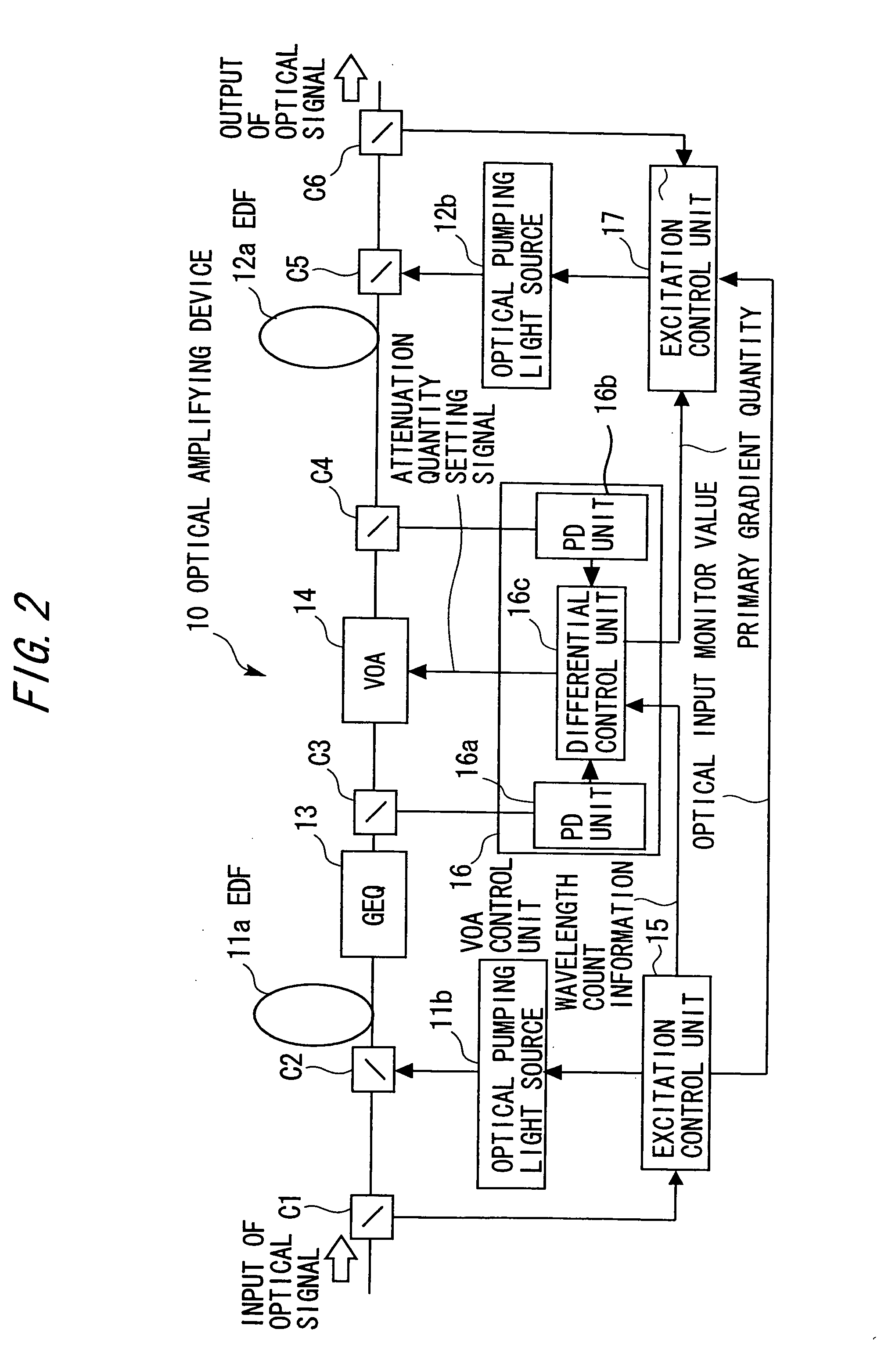Optical amplifier
- Summary
- Abstract
- Description
- Claims
- Application Information
AI Technical Summary
Benefits of technology
Problems solved by technology
Method used
Image
Examples
first embodiment
[0097] Embodiments of the present invention will hereinafter be described with reference to the drawings. FIG. 1 is a view of a principle of an optical amplifying device according to the present invention. An optical amplifying device 10 is a device for amplifying a WDM optical signal and is applied to an optical repeater in a WDM transmission system.
[0098] A first gain block 11 installed on an input side of the optical amplifying device 10 is an EDFA (Erbium-Doped Fiber Amplifier) constructed of a first amplifying medium 11a (which will hereinafter be termed an EDF 11a) in which an active substance such as erbium (Er3+), etc. for optical amplification is doped, a first optical pumping source unit 11b for emitting excitation light, and a multiplexer C2. The first optical pumping source unit 11b emits the excitation light via the multiplexer C2 installed on the optical input side of the EDF 11a. The optical signal is thereby amplified.
[0099] A second gain block 12 installed on an o...
second embodiment
Judgement from Magnitude of Out. 1 with PP Corresponding to Wavelength Count
[0170]FIG. 26 is a view schematically showing a construction of the optical amplifier according to a second embodiment of the present invention. The optical amplifying device 10 is a device for amplifying the WDM optical signal and is applied to the optical repeater in the WDM transmission system.
[0171] The first gain block 11 installed on the input side of the optical amplifying device 10 is the EDFA (Erbium-Doped Fiber Amplifier) constructed of the first amplifying medium 11a (which will hereinafter be termed the EDF 11a) in which the active substance such as erbium (Er3+), etc. for optical amplification is doped, the first optical pumping source unit 11b for emitting the excitation light, and the multiplexer C2.
[0172] The first optical pumping source unit 11b emits the excitation light via the multiplexer C2 installed on the optical input side of the EDF 11a. With this operation, the first gain block 1...
third embodiment
Identification Using Power of LD1 when Effecting AGC at Stage of GEQ
[0213] In the second embodiment discussed above, the wavelength equi-allocation power is compared with the power of the optical signal L13, thus recognizing the wavelength bias. According to the third embodiment, however, first excitation light power when controlling the power of the optical signal L13 to be fixed is compared with first excitation light power (reference excitation light power) when the wavelengths are equally allocated, thus recognizing a wavelength bias. Note that the configuration other than this wavelength bias recognizing method in the third embodiment is the same as the second embodiment discussed above has, and hence their repetitive explanations are omitted by marking the same components with the same numerals and symbols.
[0214]FIG. 30 is a view schematically showing a configuration of the optical amplifying device 10 in the third embodiment.
[0215] In the third embodiment, a first excitati...
PUM
 Login to View More
Login to View More Abstract
Description
Claims
Application Information
 Login to View More
Login to View More - R&D
- Intellectual Property
- Life Sciences
- Materials
- Tech Scout
- Unparalleled Data Quality
- Higher Quality Content
- 60% Fewer Hallucinations
Browse by: Latest US Patents, China's latest patents, Technical Efficacy Thesaurus, Application Domain, Technology Topic, Popular Technical Reports.
© 2025 PatSnap. All rights reserved.Legal|Privacy policy|Modern Slavery Act Transparency Statement|Sitemap|About US| Contact US: help@patsnap.com



